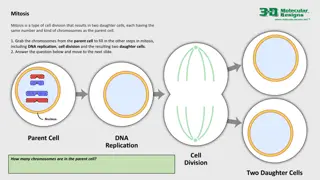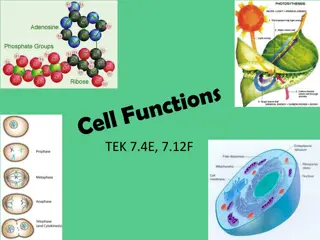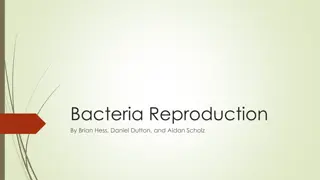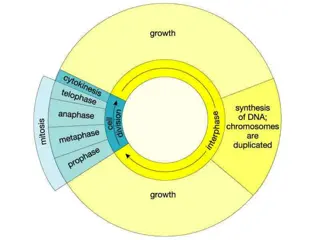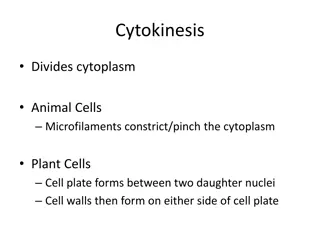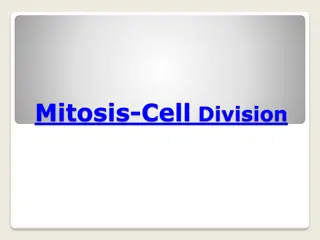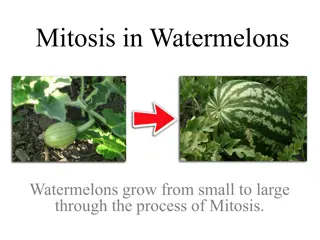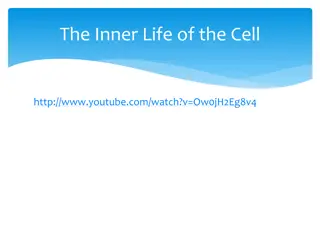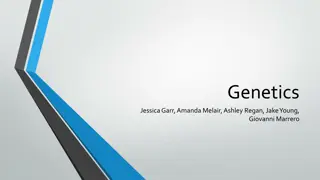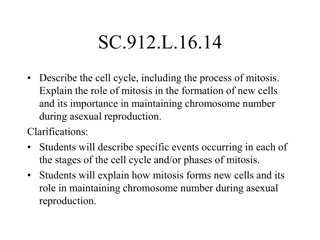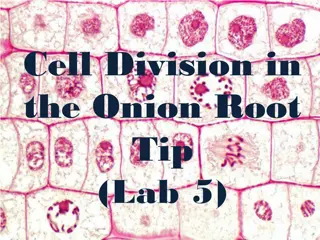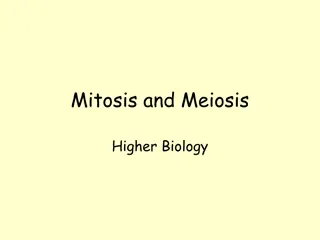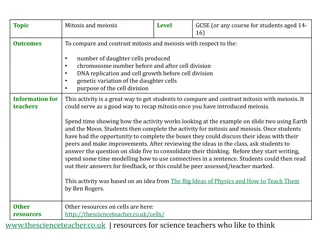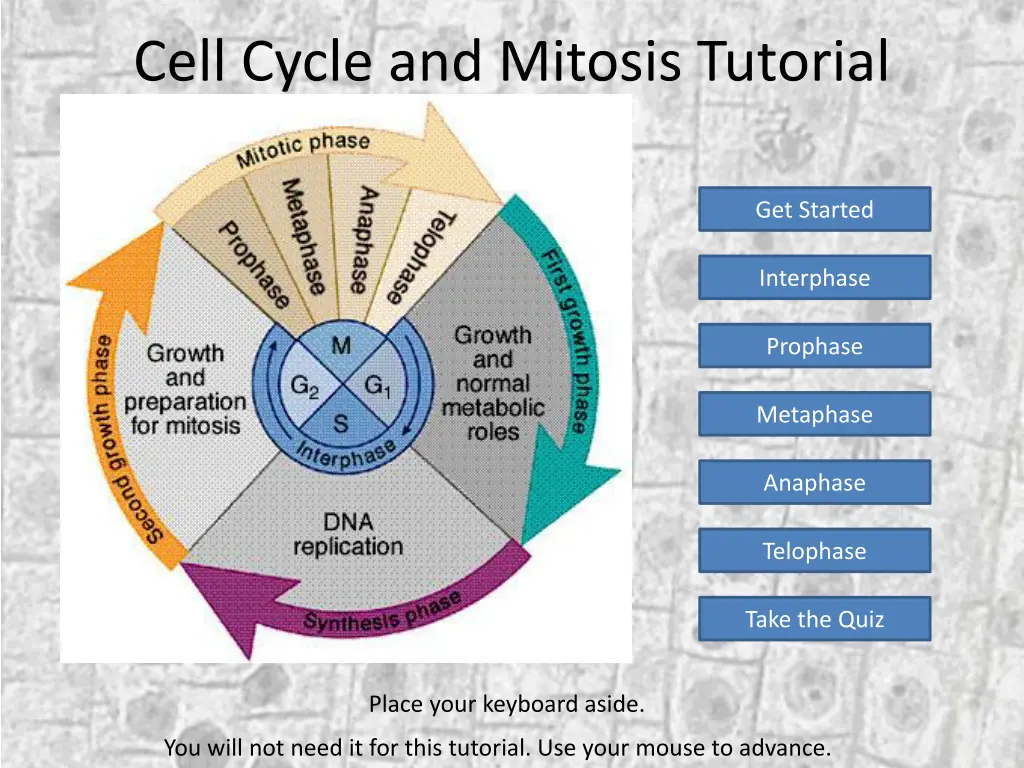
Understanding the Cell Cycle: A Comprehensive Tutorial
Explore the intricate process of the cell cycle and mitosis, from interphase to the formation of daughter cells. Learn about the stages and functions, with visual aids for better comprehension.
Uploaded on | 4 Views
Download Presentation

Please find below an Image/Link to download the presentation.
The content on the website is provided AS IS for your information and personal use only. It may not be sold, licensed, or shared on other websites without obtaining consent from the author. If you encounter any issues during the download, it is possible that the publisher has removed the file from their server.
You are allowed to download the files provided on this website for personal or commercial use, subject to the condition that they are used lawfully. All files are the property of their respective owners.
The content on the website is provided AS IS for your information and personal use only. It may not be sold, licensed, or shared on other websites without obtaining consent from the author.
E N D
Presentation Transcript
Cell Cycle and Mitosis Tutorial Get Started Get Started Interphase Interphase Prophase Prophase Metaphase Metaphase Anaphase Anaphase Telophase Telophase Take the Quiz Take the Quiz Place your keyboard aside. You will not need it for this tutorial. Use your mouse to advance.
Go Back Home What is the Cell Cycle? Go Back Home All cells go through a series of events in their life. Cells grow, divide, perform their necessary function, divide some more, and eventually die. Resting Cell As they grow and divide, a series of changes take place in order for the cell to properly divide. These stages are known as the cell cycle. As a cell progresses through the Cell Cycle it will enter the mitosis stage in the life of the cell. This is where the nucleus and cell divide to make two daughter cells. Two Daughter Cells
Go Back Home Daughter Cells Go Back Home Daughter cell is the name given to the two cells that exist when the process is finished. Because the DNA in each cell should be an exact copy, the two cells should be genetically identical. The steps that took place to create these two daughter cells is what this tutorial will address. Resting Cell The Cell Cycle can be broken down into 5 major steps: 1. Interphase 2. Prophase 3. Metaphase 4. Anaphase 5. Telophase Two Daughter Cells Proceed to Interphase Proceed to Interphase
Go Back Home Interphase Go Back Home The first stage of the Cell Cycle can be subdivided into three separate stages. As you can see in the picture, the majority of the life of the cell will be the Interphase stage. In some cells, the Interphase stage can last decades. Examine the pie graph. What percentage of time is spent in Interphase? 0% 25% 50% 75% 100% Correct Look again. What is 3 sections out of 4? Look again. What is 3 sections out of 4? Look again. What is 3 sections out of 4? Look again. What is 3 sections out of 4?
Go Back Home Interphase (G1 Stage) Go Back Home G1 Stage The 1st growth stage of Interphase is called the G1 stage. During this stage, cells are performing normal functions. For example, cells of the intestine are absorbing nutrients. As the G1 stage continues, the cell will grow larger in size. Additional organelles (mitochondria, ribosomes, lysosomes, etc ) are also created in this stage. After all, the cell will eventually split into two cells so new parts will be needed for each new cell.
Go Back Home Interphase (S Stage) Go Back Home S Stage The next stage of Interphase is the S stage. This is named S stage because DNA is synthesized during this stage. This means that an extra copy of DNA is created. One copy will be needed for each of the two cells. Here is a molecule of DNA. What will happen to this DNA molecule during the S Stage? It will be duplicated Correct. Read the paragraph. What does synthesis mean? Read the paragraph. What does synthesis mean? It will be destroyed It will be hidden
Go Back Home Interphase (G2 Stage) Go Back Home G2 Stage The 2nd growth stage of Interphase (3rd overall stage) is called the G2 stage. Just as the G1 stage, the cell continues to perform its normal functions. For example, cells of the digestive system would continue to release chemicals to help digest food. Again, the cell continues to grow larger during this stage. After all, it is about to split into two cells. Interphase example Interphase example Click the proper picture of interphase below to advance to the next stage. No No No No correct
Go Back Home Prophase (1 of 2) Go Back Home Now that Interphase is complete, the cell has entered the process of Mitosis. During the next few stages, the nucleus of the cell will divide into two and thus two daughter cells will ultimately be created. Prophase marks the start of mitosis. In the prophase pictures above, you can see the round nucleus is starting to dissolve and break apart. Notice how there are thick chunks inside the nucleus. DNA is normally inside the nucleus and is also normally in a long, linear form (kinda like strands of spaghetti). However, as prophase progresses, the long strands of DNA condense (coil) and tighten into chunky looking structures called chromosomes. In human cells, a total of 46 chromosomes will appear. The advantage of chromosomes is that the DNA is now in an easily moveable package. This will be important in the later stages of mitosis.
Go Back Home Prophase (2 of 2) Go Back Home Chromosomes form Key things to notice: -- Chromosomes form -- Nucleus dissolves -- Spindle fibers created Nucleus dissolves Click the proper picture of prophase below to advance to the next stage. correct No No No No
Go Back Home Metaphase (1 of 2) Go Back Home During Metaphase, the chromosomes (chunks of DNA) that are now fully formed are pulled by protein threads called spindle fibers towards the cell s equator (center). Spindle fibers act like a rope and lasso. Once the chromosomes are lassoed, the spindle fibers pull the chromosomes to the middle of the cell. The spindle fibers attach to locations on the chromosomes called the centromere. Notice in the two pictures above how the thick chunks called chromosomes appear near the middle of each cell. chromosome chromatid
Go Back Home Metaphase (2 of 2) Go Back Home Notice the chromosomes have been pulled to the cell equator. Just like the real picture to the left. chromosome chromatid Here is a cartoon picture of a cell with three X shaped chromosomes. Click the play button to see what the spindle fibers do. Click the proper picture of metaphase below to advance to the next stage. correct No No No No
Go Back Home Anaphase (1 of 2) Go Back Home When metaphase is finished, remember that the chromosomes have been pulled to the cell s equator. When this is finished, the stage called anaphase follows. Chromosomes (chunks of DNA) are made of two halves. Each half is called a chromatid. In the picture below, you can see that chromosomes resemble the letter X. The yellow half and the blue half are the two chromatids that make up this single chromosome. During metaphase, all the chromosomes are lined up in the middle of the cell. For humans, there are 46 total chromosomes lined up in the middle of the cell. chromosome chromatid
Go Back Home Anaphase (2 of 2) Go Back Home chromosome chromatid During anaphase, the spindle fibers that are still attached to the centromere pulls the chromosomes apart so that one chromatid (yellow) is pulled to one end of the cell and the other chromatid (blue) is pulled to the opposite end of the cell. Because the DNA of each chromatid is identical, each end of the cell will have a compete set of DNA. Cell in metaphase Cell in anaphase Click the proper picture of anaphase below to advance to the next stage. Click the play button to see what the spindle fibers do. correct No No No No
Go Back Home Telophase Go Back Home When anaphase is complete, all the chromosomes inside the cell were separated with one chromatid being pulled to each end of the cell. Click the proper picture of telophase below to advance to the next stage. During Telophase, the following events take place: -- the cytoplasm begins to divide in a process called cytokinesis. -- the nucleus has begun to reform around the chromatids of each cell. -- the spindle fibers begin to dissolve and disappear. -- The chromatids that have been pulled to each end of the cell begin to unwind back into the linear (spaghetti) form called chromatin. cytokinesis Cell in anaphase No correct No No No Chromatids unwind into chromatin Nucleus reforms
Go Back Home All Stages Back to Back Go Back Home Remember that when the process began there was one single cell. But now that Telophase and cytokinesis is complete, the cell has been split into two cells. Examine the pictures below. The pictures take you from the start of interphase (one cell) through the stages of the cell cycle until you finish with two cells. Interphase Prophase Metaphase Anaphase Take me to the quiz. I m ready! Take me to the quiz. I m ready! Telophase
Go Back Home The Quiz Go Back Home Answer each question one at a time. There are 20 total questions. Be sure to fill out your worksheet along the way. 1) Which stage of the cell cycle is this? Interphase Prophase Metaphase Anaphase Telophase correct No No No No
Go Back Home The Quiz Go Back Home 2) Which stage of the cell cycle is this? Interphase Prophase Metaphase Anaphase Telophase correct No No No No
Go Back Home The Quiz Go Back Home 3) Which stage of the cell cycle is this? Interphase Prophase Metaphase Anaphase Telophase correct No No No No
Go Back Home The Quiz Go Back Home 4) Which stage of the cell cycle is this? Interphase Prophase Metaphase Anaphase Telophase correct No No No No
Go Back Home The Quiz Go Back Home 5) Which stage of the cell cycle is this? Interphase Prophase Metaphase Anaphase Telophase No correct No No No
Go Back Home The Quiz Go Back Home 6) Which stage of the cell cycle is this? Interphase Prophase Metaphase Anaphase Telophase correct No No No No
Go Back Home The Quiz Go Back Home 7) Which stage of the cell cycle is this? Interphase Prophase Metaphase Anaphase Telophase correct No No No No
Go Back Home The Quiz Go Back Home 8) Which stage of the cell cycle is this? Interphase Prophase Metaphase Anaphase Telophase correct No No No No
Go Back Home The Quiz Go Back Home 9) Which stage of the cell cycle is this? Interphase Prophase Metaphase Anaphase Telophase correct No No No No
Go Back Home The Quiz Go Back Home 10) Which stage of the cell cycle is this? Interphase Prophase Metaphase Anaphase Telophase correct No No No No
Go Back Home The Quiz Go Back Home 11) Which stage of the cell cycle is this? Interphase Prophase Metaphase Anaphase Telophase No correct No No No
Go Back Home The Quiz Go Back Home 12) Which stage of the cell cycle is this? Interphase Prophase Metaphase Anaphase Telophase correct No No No No
Go Back Home The Quiz Go Back Home 13) Which stage of the cell cycle is this? Interphase Prophase Metaphase Anaphase Telophase No correct No No No
Go Back Home The Quiz Go Back Home 14) Which stage of the cell cycle is this? Interphase Prophase Metaphase Anaphase Telophase correct No No No No
Go Back Home The Quiz Go Back Home 15) Which stage of the cell cycle is this? Interphase Prophase Metaphase Anaphase Telophase No correct No No No
Go Back Home The Quiz Go Back Home 16) During which stage of the cell cycle does the nucleus dissolve? No No No No correct
Go Back Home The Quiz Go Back Home 17) During which stage of the cell cycle do the chromosomes align along the cell's equator? No No No No correct
Go Back Home The Quiz Go Back Home 18) During which stage of the cell cycle does the G1, S, and G2 stages occur? correct No No No No
Go Back Home The Quiz Go Back Home 19) During which stage of the cell cycle does the cell perform its normal functions? correct No No No No
Go Back Home The Quiz Go Back Home 20) During which stage of the cell cycle are the chromatids pulled to each half of the cell? correct No No No No
Go Back Home The End Go Back Home I hope this tutorial was helpful. Be sure to turn in your worksheet when finished.

